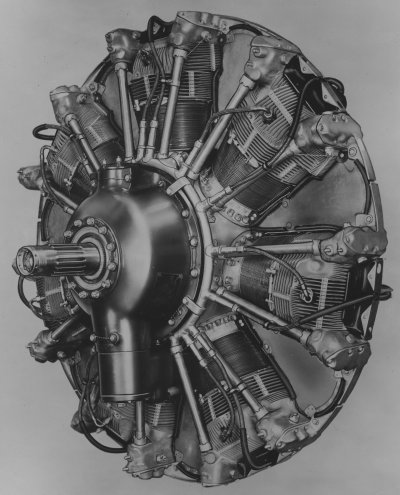

Curtiss-Wright Cyclone 7
by Carl Kuhns
 |
 |
| The Curtiss-Wright Cyclone 7 (US National Archives and Records Administration) | |
Overview
Many aircraft piston engine makers named their engines after real physical items. Rolls-Royce piston engines were named after birds of prey: Eagle, Falcon, Condor, and others. Pratt & Whitney engines were named after stinging insects: Wasp, Hornet, Yellow Jacket. Wright Aeronautical chose violent windstorms for their engine names: Whirlwind, Tornado, Cyclone, and Typhoon.
The Wright Cyclone 7 was Wright’s smallest in a long line of Wright radial aircraft engines named “Cyclone.” The other Cyclones were the R-1750 and R-1820 Cyclone 9, the R-2600 Cyclone 14, R-3350 Duplex Cyclone. The Cyclone 7 was also known as an R-1300, its military designation. It is a seven-cylinder static radial engine displacing 1,301 in³ with a take-off rating of 800 hp.
Three distinct types of aircraft used the Cyclone 7 for propulsion: fixed wing airplanes, helicopters and lighter-than-air craft.
Basic design work was started on the Cyclone 7 in 1938. In November 1939 a full-scale model was running. Because of the demands of war production and other more important experimental engines, the Cyclone 7 was put on hold until after the war ended. In a 1946 sales brochure, Wright announced that the Cyclone 7 would be desirable and available to power executive transports, small cargo airplanes and advanced military trainers.
In that same 1946 brochure Wright claimed that all Cyclone Engines had improvements and refinements in design because of the war experience.
 |
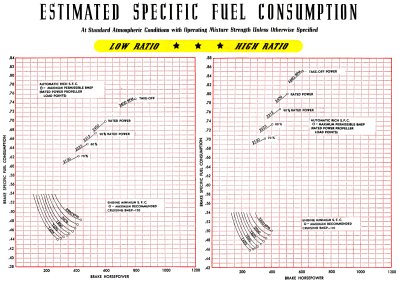 |
| Cyclone 7 Performance Curves (1946 Curtiss-Wright Brochure) | |
Construction
Construction was rather straight forward with no untried features. The crankcase was a two-piece steel forging with seven cylinders bolted to it. The steel cylinders with W Type aluminum alloy fins were screwed and shrunk into a forged aluminum alloy head containing one inlet valve and one sodium-cooled exhaust valve. Cylinders had a bore of 6.125". The one-piece master connecting rod rode on a one-throw two-piece counterbalanced crankshaft with a stroke of 6.3125". If the engine was not direct drive, the front engine case contained a planetary reduction gear with a ratio of 0.5625:1. The propeller shaft was a SAE Number 40. The rear of the engine contained a gear-driven supercharger impeller that spun at 7.21 times crankshaft speed. A Bendix-Stromberg PD-9E1 two-barrel downdraft carburetor fed fuel mixture to the supercharger. Two American Bosch SF7LU magnetos supplied sparks to the two spark plugs per cylinder. The magnetos, along with other accessories, were located at the rear of the engine.
Manufacture of Cyclone 7s
The first production Cyclone 7, a military R-1300-1, was manufactured by Wright Aeronautical Corp. in Wood-Ridge, New Jersey in February 1949. Some time in 1953, Kaiser-Frazer Corp. in Detroit, Michigan took over all R‑1300 engine production. Lycoming Division, AVCO Manufacturing Corp. of Stratford, Connecticut began Cyclone 7 production in 1955. A Commercial 990C7BA1 Cyclone 7 was the last R-1300 made when Lycoming ended production of all Cyclone 7s in 1961. The majority of Cyclone 7s produced were for the military. The total of the military and commercial production was 3,541. Only 170 commercial Cyclone 7s were made.
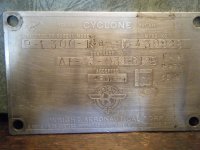 |
 |
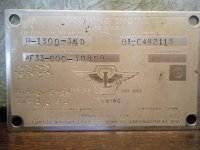 |
| Left to Right: Dataplates of Cyclone 7s Built by Wright, Kaiser-Frazer, and Lycoming. | ||
Installations
Unlike its big brother, the Cyclone 9, the Cyclone 7 was installed in relatively few aircraft. Three noteworthy aircraft powered by the Cyclone 7 are the North American T-28A military trainer, the Sikorsky S-55 helicopter, and the U. S. Navy N Class non-rigid airship.
The North American T-28A entered service with the U.S. Air Force in 1950 as a replacement for the North American T-6. The R-1300-1 was the power plant of the T-28A. North American made 1,194 T-28As between 1950 and 1958.
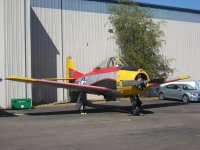 |
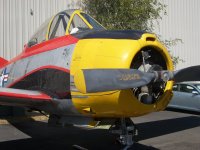 |
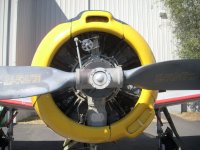 |
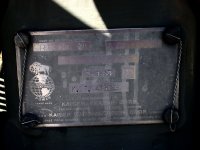 |
| North American T-28A with Cyclone 7 (Tom Fey) | |||
The Sikorsky S-55 was developed without government funds as a utility helicopter. It was first flown on November 10, 1949, powered by a Pratt & Whitney R-1340-57 of 600 hp. The U. S. Air Force, Navy, Coast Guard, Army and Marine Corps all purchased military versions of the S-55, most of which were powered by the Wright R-1300-3. The commercial model S-55s used a model 990C7BA1 Wright Cyclone 7. The S-55’s engine was mounted in the nose of the helicopter. This allowed good engine access, due to the forward mounted clam shell doors. This arrangement also allowed a large cabin volume underneath the main rotor. Earlier model Sikorsky helicopters had their engines directly underneath the main rotor. With this arrangement, loading and off loading of cargo caused undesired changes in the center of gravity.
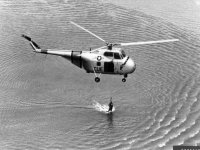 |
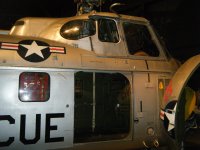 |
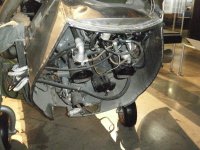 |
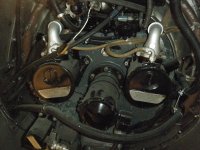 |
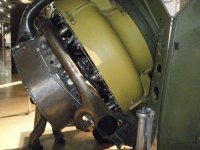 |
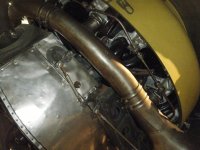 |
| NMUSAF Sikorsky S-55 with Cyclone 7 (Left Image Wiki Commons) | |||||
In the 1950s and until 1961, the US Navy operated a fleet of non-rigid airships powered by Wright Cyclone 7s. These airships were known as N Class airships and were built by the Goodyear Aircraft Corp. of Akron, Ohio. The missions of these blimps were anti-submarine warfare and all weather airborne warning. These blimps were well suited for those missions because they could remain aloft, unrefueled for long periods of time.
In March 1957 an N class airship model ZPG-2 nicknamed Snowbird flew 9,448 miles, unrefueled and non-stop. The flight departed Massachusetts, crossed the Atlantic Ocean to Africa, and returned to Key West Florida. The flight lasted 264.2 hours and averaged about 36 mph.
The N Class airships had two Cyclone 7s mounted in an engine room within the control car. Two Curtiss Electric three-blade controllable pitch, feathering and reversible propellers were mounted on outriggers projecting from each side of the control car. The propellers were driven by the engines through clutches and transmissions, so that either engine could drive both propellers or both engines could drive one propeller. This feature allowed in-flight maintenance on an engine.
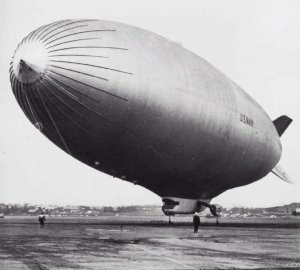 |
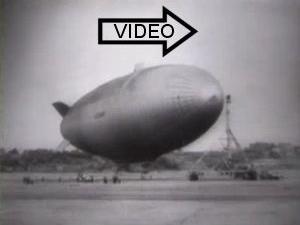 |
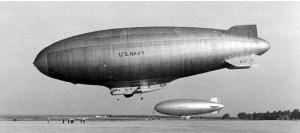 |
| N-Class Airships with Cyclone 7 Power (Wiki Commons) | ||
Cyclone 7s with CAA (FAA) Type Certificates
Type certificate number E-261 applies to model 957C7BA1. This is a geared drive engine applicable to fixed wing aircraft. Only eight of these engines were produced.
Type certificate number E-289 applies to model 990C7BA1, which is a direct drive engine installed in commercial Sikorsky S-55 helicopters. Wright produced 155 engines of this type.
Military Cyclone 7s that are operated by civilian owners fall under type certificatte 5E-14. The R-1300-1 is the engine for the North American T-28A; R-1300-3 is the engine for the Sikorsky S-55s. A total of 3,276 R-1300-1s and R-1330-3s were produced.
Specifications
| WAD Model |
Military Model |
Model Spec No |
Takeoff Rating (hp @ rpm) |
Weight (lb) |
Propeller Reduction Gear Ratio |
Supercharger Ratio |
TC No | No Built | Production Period |
Installations |
| Commercial Models | ||||||||||
| 990C7BA1 | 990A | 800 @ 2,600 | 1,070 | 1:1 | 7.21:1 | 289 | 155 | 1956 -1961 | Sikorsky S-55 Helicopter | |
| 957C7BA1 | 957C | 800 @ 2,600 | 1,065 | 0.5625:1 | 7.21:1 | 261 | 8 | 1/1952 - 10/1953 | Hispano HA-100 | |
| 744C7B1 | 744F | 800 @ 2,600 | 1,015 | 0.5625:1 | 7.21:1 | 7 | 10/1946 - 4/1947 | Unknown fixed wing | ||
| Military Models | ||||||||||
| 853C7B1 | R-1300-1 | 853 | 800 @ 2,600 | 1,065 | 0.5625:1 | 7.21:1 | 5E-14 | 1,953 | 2/1949 - 2/1954 | Goodyear Airship 2P2M, North American T-28A |
| 865C7BA1 | R-1300-2 | 865 | 800 @ 2,600 | 1,067 | 1:1 | 7.21:1 | 45 | 9/1949 - 1956 | Goodyear Airship 2PG-1 | |
| 871C7BA1 | R-1300-3 | 871 | 800 @ 2,600 | 1,080 | 1:1 | 7.21:1 | 5E-14 | 1,323 | 11/1951 - 1955 | Sikorsky H-19B, H-19C, H-19D, HO43-3, HR3-3 |
| 899C7BA1 | R-1300-4 | 899A | 800 @ 2,600 | 1,092 | 0.5625:1 | 7.21:1 | 50 | 1953 - 1957 | Goodyear Airship ZS2G-1 | |
| Prototypes and Non Production Models | ||||||||||
| R1300A2 | 624A | 600 @ 2,200 | 875 | 1:1 | 7:1 | |||||
| R1300A642 | 642A | 600 @ 2,200 | 885 | 1:1 | 7:1 | |||||
| GR1300A2 | 591 | 700 @ 2,400 | 950 | 3:2 | 7:1 | |||||
| R1300A5 | 597 | 600 @ 2,200 | 1075 | 1:1 | Two speed | |||||
| 735C7BA1 | 735D | 800 @ 2,600 | 1,025 | 0.5625:1 | 7.21 / 8.69:1 | |||||
Sources
1. FAA Type Certificate Data Sheets Numbers E-261, E-289, 5E-14.
2. Wilkinson, Paul H. Aircraft Engines of the World. 1947, 1949, 1952, 1953, 1955, 1956, 1957 Editions.
3. Janes All the World’s Aircraft. 1949-1950 Edition.
4. Wright Aeronautical Corporation. Cyclone 7 Advertising brochure, 1946.
5. N-Class Blimp. Wikipedia: http://en.wikipedia.org/wiki/N_class_blimp
6. T-28 North American Trainer. http://www.northamericantrainer.org/t-28.htm
7. S-55/H-19/HO4S/HRS Helicopter. http://www.sikorskyarchives.com/S-55.php
8. Display – National Naval Aviation Museum.
9. Wright Engines, Engine Summary, 1930-1983. http://www.enginehistory.org/reference.shtml
10. Naval Airship Association
Unless otherwise noted, all images are by the author.